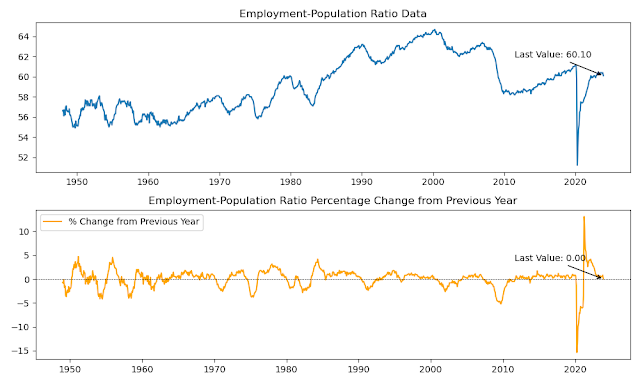The labor market is a complex and dynamic ecosystem, reflecting the ebb and flow of economic trends. As we step into the new year, it's crucial to examine the latest employment situation, particularly the data for December 2023. This information, released on January 5, 2024, provides insights into various key indicators shaping the workforce landscape.
1. Labor Force Participation Rate: A Slight Dip
The Labor Force Participation Rate, which gauges the percentage of working-age individuals actively engaged in the workforce, experienced a marginal decline of 0.48%. While this dip may seem negligible, it warrants attention as it suggests a slight contraction in the pool of active job seekers.
2. Employment-Population Ratio: A Steady State
The Employment-Population Ratio, reflecting the proportion of the population currently employed, remained relatively stable, exhibiting a slight decrease of 0.50%. Despite this decline, the rate stands resilient at a consistent level.
3. Unemployment Rate: Holding Steady with a Twist
Surprisingly, the Unemployment Rate showed no change in the monthly percentage, standing at 0.00%. However, the annual perspective reveals a 5.71% increase, indicating a nuanced employment landscape that may have evolved over the course of the year.
4. Population Level: A Modest Uptick
The overall population witnessed a marginal increase of 0.06%. While seemingly small, this growth is noteworthy as it contributes to the broader demographic context within which employment trends unfold.
5. Civilian Labor Force Level: A Slight Contraction
The Civilian Labor Force Level, representing the total number of individuals either employed or actively seeking employment, contracted by 0.40%. This dip may suggest a moderation in the labor force's size.
6. Employment Level: A Marginal Decline
Reflecting the number of individuals currently employed, the Employment Level saw a slight decrease of 0.42%. This dip, while subtle, aligns with the minor contractions observed in related indicators.
7. Unemployment Level: A Notable Uptick
Conversely, the Unemployment Level experienced a 0.10% increase, translating to a 10.00% annual change. This rise in unemployment suggests challenges within the job market, potentially influenced by broader economic shifts.
8. Not in Labor Force: An Increase with Nuances
The category of individuals not in the labor force, often comprising retirees, students, and those choosing not to participate actively, witnessed a notable 0.85% increase. Additionally, those not in the labor force but actively seeking employment rose by 6.14%, marking a considerable annual change of 9.97%.
In summary, the December 2023 employment data presents a mixed bag of indicators. While some aspects, such as the stable Unemployment Rate, provide a sense of continuity, subtle shifts in other metrics suggest underlying changes in the labor market. As we navigate through the intricacies of these statistics, it becomes imperative for policymakers, businesses, and individuals alike to adapt strategies that align with the evolving dynamics of the workforce landscape.











No comments:
Post a Comment